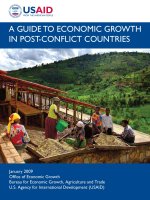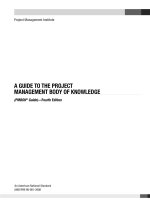compromising palestine a guide to final status negotiations
Bạn đang xem bản rút gọn của tài liệu. Xem và tải ngay bản đầy đủ của tài liệu tại đây (3.05 MB, 289 trang )
Compromising Palestine
Compromising
Palestine
A Guide to Final
Status Negotiations
Aharon Klieman
New York Columbia University Press
The Jaffee Center for Strategic Studies at Tel-Aviv University
Columbia University Press
Publishers Since 1893
New York Chichester, West Sussex
Copyright © 2000 Aharon Klieman
All rights reserved
Library of Congress Cataloging-in-Publication Data
Klieman, Aaron S.
Compromising Palestine : a guide to final status negotiations /
Aharon Klieman.
p. cm.
Includes bibliographical references and index.
ISBN 0–231–11788–4 (cloth). — ISBN 0–231–11789–2
(pbk.)
1. Arab–Israeli conflict—1993– —Peace. 2. Palestine—
International status. I. Title.
DS119.76.K55 1999
956 05'3—dc21
99–331394
Casebound editions of Columbia University Press books are printed
on permanent and durable acid-free paper.
Printed in the United States of America
c 10 9 8 7 6 5 4 3 2 1
p 10 9 8 7 6 5 4 3 2 1
With respect for Professor William V. O’Brien
friend, scholar, believer
and in memory of Aharon Yariv
above all else,
a distinctly Jewish general
Contents
List of Maps viii
Acknowledgments ix
Introduction 1
PART ONE Palestine, Peacemaking, and Partition
Chapter 1. Just Stability, or a Just Peace? 11
Chapter 2. First Choice or Last Resort? 25
Chapter 3. Partition and Palestine 45
PART TWO Facts on the Ground
Chapter 4. Within the Confines of Palestine 69
Chapter 5. Borders and Security 87
Chapter 6. Fair Share: The Economics of Partition 115
Chapter 7. Jerusalem 137
PART THREE Mapping Palestine
Chapter 8. The Elusive Middle Ground 161
Chapter 9. Safe Passages 189
Chapter 10. Toward a Negotiated Territorial Compromise 221
Notes 245
Index 269
Maps
1. Palestine and Transjordan Under the British Mandate 43
2. The 1937 Peel Commission Partition Plan 55
3. The 1947 United Nations Plan of Partition 57
4. The 1949 Armistice (“Green”) Line 58
5. The 1967 Cease-Fire Lines 59
6. The Middle East Regional Map 71
7. The West Bank: Map of Jewish Settlement 77
8. The Gaza Strip: Map of Jewish Settlement and Border Crossings 78
9. The Oslo II Map (Areas A, B, and C) 92
10. Jordan River Crossings 94
11. Close Proximities 106
12. The Proposed Gaza Maritime Zone 110
13. Hydrostrategic Map and the Yarmuk River System 131
14. Divided Jerusalem, 1948–1967 140
15. Hebron 1997 156
16. The Original Allon Plan 169
17. The Alpher “Minimalist” Plan for Territorial Compromise 171
18. The 1994 Cairo “Safe Passages” Map 198
19. The 1995 Washington “Safe Passages” Map 199
20. IDF Deployment Map and West Bank Road Grid 213
Acknowledgments
I use this opportunity to express personal appreciation to a number of sup-
portive individuals and institutions, without in any way implicating them
either in the analysis or the argument made in the following pages.
In the first instance, a debt of thanks is hereby paid to three successive
directors of the Jaffee Center for Strategic Studies at Tel-Aviv Univer-
sity: the late Aharon Yariv, Professor Ze’ev Maoz, and Professor Shai
Feldman. This acknowledgment extends to the center’s full complement
of research associates who read and commented extensively on a first
draft of the manuscript, with a special bow this time to Moshe Grundman
for his cartographic rescue operation. Second, the Tel-Aviv University
Faculty of Social Sciences and the Nahum Goldmann Chair in Diplomacy
for support, material and otherwise. So, too, the director and deputy di-
rector of the Tami Steinmetz Center for Peace Research, Professor Efraim
Ya’ar and Dr. Tamar Hermann, for enabling two interlinked projects on
procedural and substantive Middle East peacemaking to run parallel.
Early formulations of my central partitionist theme were presented be-
fore two discerning academic audiences. In 1995, at the University of
Chicago’s P.I.P.E.S. Seminar, co-chaired by Professors Charles Lipson and
Duncan Snidal. In 1997, in Dean Tom Farer’s student-faculty seminar at
the University of Denver’s Graduate School of International Studies, where
I benefited in particular from fruitful discussions with Professors Barry
Hughes and Karen Feste and from Yakub Halabi’s timely bibliographic aid.
Closer to home, behind this book are a battery of exceptionally devoted
research assistants: Avi Muallem, Barry Bristman, Nadav Morag, Hani
Zubaida, and Eilon Yavetz. Similarly, I can boast that Professors Abra-
ham Ben-Zvi, Shaul Mishal, and Yossi Shain within my own Political
Science Department at Tel-Aviv have been as uncompromising in their
probing questions as in their tested collegiality.
A penultimate word of appreciation goes to a prized colleague of many
years’ standing, Professor Joel Migdal. The final prepublication ac-
knowledgment is reserved for Columbia University Press staff: Kate Wit-
tenberg, editor in chief, two anonymous reviewers, and Susan Pensak, se-
nior manuscript editor.
The last word, however, is truly saved for my wife, Adrian. Let our
thirty-fifth anniversary and family attest to a commitment that long pre-
dates, and vastly supersedes, any PC computer.
x Acknowledgments
Compromising Palestine
Introduction
Partition, which prescribes dividing contested land in order to avoid or to
terminate ethnic conflict, is currently at the center of Middle Eastern
peacemaking. And, we hasten to add, not for the first time in the long,
singularly bloody and seemingly interminable Arab-Jewish struggle for
undivided, unshared mastery over Palestine.
Here, in the much promised but overly compromised Holy Land, par-
tition has a past as well as a future. Both its history and its prospects are
biased, however. Prejudiced in the former by a legacy of failure and in
the latter by inauspicious, nonsupportive elements: geographic and de-
mographic determinants that defy notions of a “clean cut” or a “neat di-
vide” between Arab and Jewish nationalists.
Nevertheless, that said, partition’s present and foreseeable centrality is
all but assured. This is true irrespective of whether the many schemes
now on the table for a permanent Israeli-Palestinian settlement explicitly
refer by name to the redistribution and redivision of land as partition, or
whether they choose instead to employ any one of a string of slogans and
euphemisms masquerading as political and territorial partition.
Take your pick from a rich, bewildering array of themes and schemes
that form the vocabulary of partition. The fine line in Hebrew between
Arab and Jewish “detachment” (hafrada) and “disengagement” (hipar-
dut). “Permanent closure.” “Land for peace.” The “one land for two
peoples” thesis . . . the “two-state solution” . . . “separation” as espoused
by Israeli Prime Minister Ehud Barak . . . “territorial compromise” . . .
“functional” partition . . . “hard” versus “soft” partition.
A unilateral declaration of Palestinian independence, with or without
Israel’s consent? The 1996 Beilin-Abu Mazin draft accords? Possibly a
modified “Allon plan,” or Binyamin (Benjamin) Netanyahu’s 1997 trial
balloon of “autonomy plus, state minus”? Any one of Israel’s “Jordan-
ian,” “Palestinian,” or hyphenated “Jordanian-Palestinian” options? Or
perhaps one favors Shimon Peres’s captivating vision of a closely inte-
grated trilateral “Benelux-like confederation” formed by separate Israeli,
Palestinian, and Jordanian units in league together for the collective good?
Whatever our individual peace models and preferences, these various pro-
posals have one, perhaps two definite features in common. Being verbal for-
mulas, they are singularly vague. More important, they go beyond unilat-
eral victory, capitulation, and physical elimination of one side by the other
in search of a middle ground. They are moderate solutions. They mandate
Arab-Jewish compromise; political and territorial compromise. As such,
they all embody the irreducible core strategy of dividing, of sharing, and of
ultimately cohabiting parts of the contested land. In a word, partition.
The reasoning for partition’s renewed prominence in the quest for peace
is twofold. First, with the 1993 accords Middle East peacemaking has en-
tered a new and possibly decisive phase. Once this happens in negotia-
tion and bargaining situations, words like “permanent” and “precise” take
the place of “intermediate” and “ambiguous.” In their on-again, off-again
negotiations Israelis and Palestinians have moved from procedures and
technical questions to substantive peace goals and tangible peace maps.
Also, second, because territorial partition assumes singular relevance in
raging conflicts like Palestine, where the struggle from the very outset has
been over land and physical space, which is where it remains at present.
By solemnly signing the Oslo declaration of principles these two his-
toric protagonists turned interlocutors, Israelis and Palestinians, have un-
dertaken a profound change in the basic patterns of their relationship. In
one fell swoop they have gone from delegitimizing each other to extend-
ing mutual recognition. Opting for peace over enmity, they have shifted
from uncompromising all-or-nothing positions to political and territorial
compromise. And, in choosing to move forward instead of temporizing
and remaining locked in place, they have forced us to look beyond mak-
ing peace to peace building.
Not only levels of expectation have been transformed; the very nature
and content of the discourse has as well. Only a few short years ago we
might still have been terribly impressed by the fact that Israeli and Pales-
tinian interlocutors physically sit in the same room and actually talk to
each other (or about each other to American and European go-betweens).
After the 1998 Wye plantation summit and the Wye River memoran-
dum, the world is no longer prepared to rest content with pleasantries and
handshakes, however; or quite so impressed by press releases reporting
meetings as “constructive” and “businesslike.” Why? Not because we
have become jaded in our views, but because our sights are raised higher.
Perhaps some of us, quite frankly, because of frustration with the entire
2 Introduction
Palestine issue and a desire to see the volatile, unending Mideast conflict
struck from the global agenda. Others of us, because of Oslo’s and Wye’s
tantalizing effect. After all, both sets of talks offer a fleeting vision of
peace and reconciliation as attainable, and within immediate reach.
Whatever one’s motive—desperation or inspiration—peace enthusiasts
sense that after Oslo, and with Israel’s 17 May elections now behind us,
there is no turning back. Too much has transpired; also, there is too much
at stake. Nor are the set of global, regional, or internal circumstances and
the latitude for making compromises likely to improve in the near future.
Today, consequently, in lobbying to move the peace process into the
final status phase, we have every reason—and right—to insist negotia-
tions between official Israeli and Palestinian representatives be focused
and intensive: focused on peace constructs and peace maps; intensive, in
moving more quickly from resolving misunderstandings to ratifying un-
derstandings and then to carrying them out to the letter of the agreement.
Still, for all their importance, the 1993 Oslo accords provided only a
mechanism and a format. They did not explicitly provide the solution.
The search is now on, therefore, for a definitive end to the interminably
long and prohibitively costly Arab-Israeli blood feud. As of 1999 the em-
phasis in Arab-Israeli conflict resolution has shifted from procedural gam-
bits to substantive constructs, and from so-called constructive ambiguity
to drawing lines on a real map.
Even though we are forced to concentrate daily on new, interim, often
unanticipated and not uniformly encouraging developments, surely it is
within our individual and collective capacity to wrestle with the longer-
term aspects of the peacemaking process. Where is it heading? Where
should it be going? What will need to be done, or avoided, after the peace
agreement goes into effect?
Statesmen, government and ministry officials, conflict management ex-
perts, students, academics, and lay persons—each of us is finally being
forced by the Israeli-Palestinian peace process to face questions so basic
that they challenge our most personal individual philosophies and funda-
mental political beliefs. Questions so controversial as well as tangled and
complex for peacemakers that they have been postponed until now. But,
hopefully, not for much longer.
Must all international problems have a solution? Do all wars neces-
sarily end? Are we therefore about to give thanks in 1999 . . . perhaps by
the year 2000 or at the latest 2001 . . . for a halt, at long last, to unre-
lenting strife in the Holy Land?
But, if so, how high a price are each of us (Israelis, Palestinians, their
Introduction 3
respective Jewish and Arab backers at a safer distance removed, an on-
looking world audience) actually prepared to pay for a peaceful settlement?
Let there be no misapprehensions. Without painful concessions by all
the parties directly and even indirectly concerned this historic clash of
wills between Arab nationalism and Jewish nationalism could just possi-
bly endure as a tragic exception. An exception to the premise of univer-
sal conflict termination (the “all wars must end” postulate). And an ex-
ception to the renewed premillennial drive in world affairs aimed at
resolving outstanding disputes like Northern Ireland and Bosnia by pa-
cific means and through concerted international pressure.
Again, there is no room for misreading the severity of the objective
situation in the Holy Land. This is no ordinary squabble or blackboard
exercise in conflict resolution. We are talking here about a modern Hun-
dred Years’ War between Arab and Jew that has raged on for the better
part of this century. A bloody altercation, which thus far has managed to
defy every effort imaginable at reconciliation, thereby combining the
worst features of both “enduring rivalries” and “recurring conflicts.”
1
But
also one that, its hallmark features aside, offers invaluable lessons and in-
sights into the dynamics of dispute settlement in general. Which also
means, in turn, that this particular quarrel (also commonly referred to as
the perennial “Palestine problem” and the permanent “Mideast crisis”)
has, if anything, been overstudied and overanalyzed.
What the current situation really begs for are less backgrounders and
historical perspectives than concrete answers. Practicable, workable so-
lutions are needed yet are in short supply. For there is no perfect endgame
or “exit strategy” for Palestine; only painful compromises. Foremost: ter-
ritorial compromise.
To the above battery of dilemmas and political-philosophical questions
one more specific question now needs to be added. How does the reader
respond associatively to the very mention of partition? Does it suggest
something sinister and unjust? Is it nothing more than a cynical, short-
term, and ultimately ineffective expedient? Or, alternatively, something
consistent with the spirit of fair share and fair division? For that matter,
as long as we are playing word politics, might territorial compromise—
substituting for partition—strike a different, less discordant note?
Considering less cogent, less appealing, or entirely unrealistic options,
and daring to look ahead to the final act of Arab-Israeli peacemaking, this
book poses the thesis of partition’s inescapability. Under prevailing con-
ditions some model for reapportioning and repartitioning Palestine repre-
sents historical and diplomatic inevitability.
4 Introduction
Land sharing becomes a necessity because there is no other way out of
the mystifying maze that is Israel/Palestine. Consequently, I shall be argu-
ing that inasmuch as time and patience are required to bring peace to Pales-
tine, the partitionist strategy of dividing land through political and territorial
compromise is going to figure in all peacemaking efforts. The other part of
my thesis underlines that the most nationalistic Israeli and Palestinian sepa-
ratists can hope for under the jumbled circumstances prevailing today is “par-
tition plus.” Meaning the notion of political distinctiveness moderated by,
and combined with, degrees of integration and coordination.
It would be the height of presumption for anyone to step forward so
late in the Palestine struggle with a new vision and an original formula
for peace. Especially when so many others—a veritable gallery of “the
best and the brightest” in the arts of diplomacy and peacemaking—have
tried, and failed. Neither am I as an academic responsible for or equipped
to enter into the operational details or myriad technical aspects involved
in delineating precise boundaries. Therefore, in making this argument for
partition’s guaranteed prominence my intention is not to preempt the of-
ficial negotiators—only to goad them, and their circle of attending crit-
ics, scholars, and commentators, into confronting the endgame sooner
rather than at the very last moment.
Nor, again, is my role that of advocate for a particular set of specific de-
tailed peace arrangements. More than fifty years of studying, teaching, re-
searching, living, and arguing the Palestine problem have taught me better.
Rather, by investigating specific peace issues, divergent positions, and, lit-
erally, down-to-earth solutions, I intend to show the complexities awaiting
any attempt at converting the partition principle into practice, even though
partition may well be the only way out for Israelis and Palestinians.
This extended essay is put forth as a companion guide to the perma-
nent status negotiations that already are badly behind schedule but nev-
ertheless formally underway. My focus and research design are therefore
pitched at the intermediate level: between broad general principles mas-
querading as grand theory and, at the other extreme, operational map draw-
ing. By the same token, my time frame goes well beyond May 4, 1999,
or any other arbitrary date or marker along the way to a peace settlement,
looking to the settlement itself.
In this way the following pages should provide a useful reference point
whichever one of the two possible eventualities does actually result: ne-
gotiating success or negotiating failure.
In the former, best-case scenario, should the diplomatic process begun
at Oslo in 1993 succeed at some point in the future, it will be because Is-
Introduction 5
raeli and Palestinian leaders by then will have concurred in any one of
the partition-based variants, converting it into a far-reaching political com-
promise. If so, then this primer on the territorial dimension of the final
status talks goes well beyond the bounds of an academic nonpolicy
paper.
On the other hand, past performance cautions that peace efforts can
just as easily miscarry. With Israelis and Palestinians united as one in
fiercely refusing to give ground (both literally and figuratively), the road
to an agreed repartition is paved with bad intentions. Just as the road it-
self is obstructed with countless ruts and potholes in the form of legiti-
mate sentimental, economic, security, and other concerns.
For this reason it is altogether conceivable that the directly concerned
parties may find no single form or expression of territorial compromise
acceptable—or workable. In that worse-case scenario, even though re-
duced to a purely “academic” study in the sense of being antiquated and
passed over, this paper unfortunately will have provided the reader with
as compelling a set of reasons and explanations as any for the lamenta-
ble failure, yet again, of Arab-Israel reconciliation.
Especially at the present moment, however, and without prejudice to
the outcome, the partition-for-Palestine prescription merits close scrutiny
at several levels. First, deep within the Israeli polity, itself sharply divided
over exactly where to retain, divide, yield, or exchange territory. Like-
wise, in the Palestinian national movement, where the question is more
whether rather than where to compromise on land. Second, across the bar-
gaining table: in the spasmodic official bilateral negotiations between the
two territorial claimants and hence would-be partitionists: Israel and the
Palestinian National Authority. The territorial compromise principle is
now intimately part of the permanent status talks, clearly establishing the
direct linkage between Palestine, partition, and peacemaking. Third, along
the sidelines: among outside observers, including foreign governments,
media commentators, the international academic community, and inter-
ested third parties in the United States and at the United Nations.
It is here, in each of these three different public domains, that parti-
tion’s controversial nature and divisive influence are manifestly to be felt.
Indeed, what has always blunted rather than aided in sharpening political
discourse over partition is the extreme lack of precision in our usage of
the term itself—as a concept, as a sketchy blueprint, or as a specific pol-
icy course of action.
In the words of Yossi Beilin, one of the chief architects of the Oslo
accords, Arabs and Israelis “are speaking more or less about the same so-
6 Introduction
lution. Despite using other words, other symbols, we know more or less
what the solution will be.”
2
One assumes the inclusive “we” refers to all
three of the above-mentioned levels of analysis and discussion. Again,
the two official sides squared off against each other across the bargain-
ing table, but also among the different schools of thought and political
factions within each respective camp, because Arabs and Jews, Israelis
and Palestinians are not monolithic and do not necessarily speak with one
voice. Not to be left out are those countless outsiders and well-wishers
anxious to see this latest diplomatic effort eventuate in a real, lasting Mid-
dle East peace. They, too, are welcomed under Beilin’s canopy of gen-
eral consensus. Peace, after all, is the great unifier.
Unfortunately, I must disagree. Because, leaving everyone else out for
the moment, Israelis and Palestinians are in fact poles apart. As the post-
Oslo posturing and excruciating negotiations fully and readily confirm,
even following the Wye River memorandum, we are not in full agree-
ment about what the permanent status solution will be or should be.
And nothing succeeds in dividing us quite so much as efforts at inter-
preting partition’s exact meaning. Why? Principally, because there is a
difference, a profound difference, between “partition” and “territorial
compromise” and between “territorial compromise” and “land for peace.”
Ambiguity therefore no longer really serves the cause of peace. “More
or less” is no longer good enough. For far too long we have gotten away
with leaving peace and the precise terms of peace for the future . . . when
conditions are ripe . . . not before attitudes have changed . . . only when
the general situation is more conducive . . . until such time as success is
assured.
Lack of a precise, agreed upon exit strategy has been a consistently
troubling omission in Middle East peace efforts. It has consistently
plagued implementation of the Oslo and Wye agreements. Now that fo-
cusing on the hypothetical permanent status is no longer premature, this
becomes a glaring omission. The time for confronting peace is close at
hand. That we have already overshot and gone beyond the May 1999
deadline set for finalizing the Madrid-Oslo peace process merely adds to
the sense of immediacy by intensifying the inquiry into the architecture
of an Israeli-Palestinian peace.
My concern is not with the merits and necessity for peace. This much
ought to be patently self-evident. Nor with dates, deadlines, or time ta-
bles. Rather, in this book I am raising two questions: (1) the meaning and
substance of peace, and (2) the price it must inevitably extract—politi-
cally and territorially—from all parties concerned. Because this is not a
Introduction 7
running commentary on the pre-Oslo and Oslo phases, or the post-Oslo
and Wye interim talks, but a consideration of the issues and dynamics
likely to dominate the final round of permanent status negotiations, what
most interests me is not “Gaza-Jericho first” but what comes afterward.
Still more specific: What comes last when the dividing line needs to be
penciled in between Israelis and Palestinians, between an Israel and a
Palestine? The operative question is whether a peace map based upon ter-
ritorial compromise can be drawn between minimal Israeli and Palestin-
ian objectives.
Today we are compelled not only to clarify our intentions but to de-
fine our peace terms. Going beyond whether or not there ought to be a
Palestinian state—the question seems all but moot by now—this book
poses an entirely different set of practical issues: that state’s exact loca-
tion and boundaries; how large a state; its relations with Israel and Jor-
dan respectively; and what it will mean for Israel to have Palestinian
neighbors to the east . . . and to the west.
On this point I entirely agree with Professor Edward Said that what is
now needed is “a discipline of detail”
3
—one yielding counterstrategies
and countermaps. Then, and only then, will we have a better feel for the
true prospects of lasting peace. In effect, this study calls for going be-
yond catchwords and slogans while yet stopping short of tabling minutely
detailed and elaborate schemes that, in any case, are best left to the offi-
cial negotiating parties themselves.
A durable peace between the two communities resident in the Holy
Land is arguably the world community’s largest piece of unfinished busi-
ness in its war against deadly conflicts. Viewed in broad, metahistorical
terms, we may very well be witnessing at the present moment the final
momentous chapter in the long and unbearably tragic struggle for Jew-
ish, and Arab, self-determination, vindication, and—above all—land pos-
session. Innocent bystander, distant observer, and direct participant alike:
we are all permitted the fervent wish that this forthcoming chapter be
sealed in ink rather than blood.
Thus motivated, this monograph of reflections on partition hopes to
contribute to the quality of analysis at each level of debate as Israeli-PLO
conflict resolution enters the critical countdown after May 1999 and the
crafting of a detailed peace blueprint. On the ground and not only on pa-
per. The confining, inhospitable ground of geographic, demographic, his-
toric Palestine.
8 Introduction
PART ONE
Palestine, Peacemaking,
and Partition
Chapter 1
Just Stability,
or a Just Peace?
I can feel it in my bones that there’s an answer out there if you can only
find it.
—American secretary of state George Shultz (April 3, 1988)
The term ripeness has gained tremendous currency among students and
practitioners of international conflict resolution. This wide acceptance
doubtless traces in the first instance to the commonsense logic behind the
idea, and to its very simplicity, but also to an awareness among researchers
that the causes of hostility have been overemphasized: why wars start
rather than why, how, and when they end—or can be induced to end.
The conflict termination process itself demands further investigation.
In particular, those terms of settlement that make termination possible as
well as the kinds of outcomes that can be anticipated. What, for exam-
ple, determines success or failure in peacemaking? Why do formal peace
pacts take hold and stick in some cases and break down in others, some-
times unraveling almost the next day? Which formulas tend to work best?
Which are the most durable?
Conflicts Ripe for Resolution
In essence, the theory of ripeness claims that in negotiating, especially in
actually resolving political disputes, we have the capacity to engineer
diplomatic breakthroughs. Breakthroughs as genuine as they are dramatic,
based upon the existence, or nonexistence, of readily identifiable pre-
conditions.
1
I. William Zartman argues that a conflict is ripe for resolu-
tion when it becomes a “hurting stalemate” for both antagonists.
2
Fen
Osler Hampson is willing to settle for “a level playing field.”
3
Other schol-
ars prefer to emphasize the positive by stipulating a convergence of ex-
pectations or by keynoting the availability of incentives and inducements.
4
Popularity aside, the general notion of ripeness still lacks precision.
Whether from the standpoint of its analytical rigor, its predictive powers,
or, for that matter, its political utility, it is not an easy concept to opera-
tionalize.
Richard Haass, an early proponent of the ripeness school of conflict
resolution, postulates four essentials to major diplomatic progress: a
shared perception of either the need or the desirability for an accord, the
readiness of both parties to compromise, their domestic enforcement ca-
pabilities, and a mutually acceptable approach or process.
5
While cer-
tainly a step in the direction of making the ripe-unripe distinction more
concrete, nevertheless, Haass’s criteria still remain too broad.
International statesmen, also those already sensitized through years of
experience to the critical importance of timing, would heartily welcome
guidance from scholars. Most particularly, first, in gauging the preferred
stage of fighting (or bargaining) when the timely application of concerted
diplomatic leverage is going to have the most telling effect upon the out-
come of the quarrel and, then, within that given stage, the precise mo-
ment for acting and intervening.
Regrettably, these specific signposts for distinguishing an optimal
moment of true ripeness from prematuration and, on the other hand,
postripeness, remain unclear. And, in the abiding absence of such mark-
ers, the great majority of contemporary regional and interstate disputes,
as well as internal ethnic and intercommunal ones, continues to yield the
bitter fruits of elusive peace. Missed opportunities either because seized
upon too early or too late.
Equally important is a second distinction: between merely suspending
or deferring a lethal dispute, and ending it definitively—between, in short,
conflict management and dispute settlement or conflict resolution. To truly
qualify for the latter category, a commitment by an outside third party or
set of intermediaries must go considerably beyond addressing only a sin-
gle aspect or dimension of the larger dispute. So, too, must that commit-
ment, once made, refuse to settle for stopgaps and quick fixes that so of-
ten pass for diplomatic window dressing. It has got to aim at answering
all outstanding differences.
Add two further criteria. A terminated conflict and a durable peace can-
not be artificially hastened. Just as, strictly speaking, it is not advisable
that the terms of settlement be coerced or imposed—whether by one ad-
versary on the other or by a third party on both.
For these reasons, the maximalist goal—conflict resolution—stands
apart: qualitatively different and extremely rare. Far more common, and
12 Palestine, Peacemaking, and Partition
Just Stability, or a Just Peace? 13
readily (some might say, all too conveniently) available to would-be
peacemakers, is an otherwise impressive sliding scale of juridical, diplo-
matic, and humanitarian half-measures ratcheting upwards from momen-
tary cease-fires and improvised truces to more ambitious and semiper-
manent interim agreements like armistice, separation of forces, and
nonbelligerency. Whatever may be said for each of these “regimes,” they
are in fact essentially short-term “neither war, nor peace” palliatives con-
centrated at the lower spectrum of peacemaking. They focus above all on
the continued absence of armed hostilities, and for as long as possible.
This is not to gainsay any of these efforts or to disparage such partial
gains as are achieved through them. Indeed, many respected analysts, pos-
sibly exhibiting a heightened sense of realism, are perfectly content to
live with containing interethnic and other disputes, what Fearon and Laitin
refer to as “cauterizing.”
6
Rather, the aim at the outset of this study is to insist upon differentia-
tion. Distinguishing between what scholars contrast as “negative peace”—
the prevention, cessation, or absence of war or hostilities in general—and
“positive peace”—the elimination of the underlying structural causes and
conditions that gave rise to the violent conflict in the first place.
Stability must never be confused with peace. Most emphatically, the
two are not synonymous. Whether applied to the Middle East, or any other
international trouble spot, peace and stability profoundly differ from each
other in the respective degree of political commitment and resolve and,
hence, again, of conflict resolution as opposed to “merely” or “simply”
moderating and ameliorating lethal conflicts.
Judged by this strict twofold standard of (a) timing and (b) intent, it is
more readily understandable why the diplomatic record discloses far fewer
genuine peace breakthroughs than ad hoc arrangements, more false starts
than finish lines. Also, why too many Nobel prizes for promoting peace
have been ceremoniously awarded prematurely. A useful starting point,
therefore, is to note what ripeness is not.
Druckman and Mitchell observe with admirable conciseness that in-
ternational conflicts persist unresolved due to “an unwillingness to arrive
at solutions acceptable to all the disputing parties and their constituen-
cies.”
7
Albeit couched in negative, dysfunctional terms, their statement
highlights certain key variables. Deconstructed, “unwillingness” clues us
to a poisoned atmosphere marked by intransigence (the opposite of con-
ciliation and compromise) among the “disputing,” highly contentious par-
ties, with “all” signifying an arbitrary, indeterminate number of them.
Failure to reach consensus on “solutions” that are “acceptable” applies,
in turn, to substance, i.e. the absence of a peaceful exit strategy; whereas
“arriv[ing] at” alludes, in the last instance, to technique—an as yet un-
finished and possibly unsatisfactory peacemaking process.
These shortcomings might just as easily be turned around to under-
score their presence rather than their absence. So that heading the peace-
maker’s agenda will be (a) building confidence, (b) compromising goals,
(c) ranking the parties concerned, (d) processing peace, (e) yet packag-
ing the peace as well. Once rephrased into positive terms, the above sen-
tence in fact encapsulates the essential ingredients for a paradigm of
ripeness.
Five Steps to a Diplomatic Breakthrough
Peacemaking is both a matter of consecutive phases and of controlling
for variables. These latter factors intrude in and throughout each of the
successive phases, from prenegotiation to what former UN Secretary-
General Boutros Boutros Ghali was fond of calling, and right in stress-
ing, “post-conflict peace building,” otherwise known as normalization of
relations. Moreover, any of the several variables can exercise either a pos-
itive or a negative influence at each equally sensitive and delicate stage.
Building upon the work of Haass, Zartman, and others, when reduced
to essentials, the war-ripeness-peace correlate, and with it the conflict ter-
mination process, can now be seen as really a function of five determi-
nants. First and second, the identity and cultural profile of the belliger-
ents and their respective interests, objectives, and capabilities. Third, the
climate prevailing at any particular moment, as affected by self-percep-
tions as well as the principals’ attitudes toward each other. Fourth, the
range of bargaining procedures, “good offices,” and negotiating “tracks”
at their disposal. Plus, fifth, the repertoire of final status peace solutions.
It is also important to appreciate that these variables are interactive as
well as interdependent. Which is another way of saying that all five are
equally important. A composite theory of ripeness insists that if the war-
ring sides are to move from situations of pure conflict (the pole of en-
mity) toward pacific dispute settlement followed by normalization (the
pole of amity),
8
major adjustments ought to occur, by right, in each and
every one of the five categories if not simultaneously, then at least cu-
mulatively, and in order to create that optimal moment of exquisite diplo-
matic full-bodied ripeness.
Without prejudice to the exact sequence by which each piece of the
puzzle is put into place, in the end such transformations involve:
14 Palestine, Peacemaking, and Partition








![cruising alaska [electronic resource] a guide to the ports of call.](https://media.store123doc.com/images/document/14/y/ba/medium_bal1401351374.jpg)
![cruising the mexican riviera and baja [electronic resource] a guide to the ships and the ports of call.](https://media.store123doc.com/images/document/14/y/pc/medium_pcm1401351395.jpg)